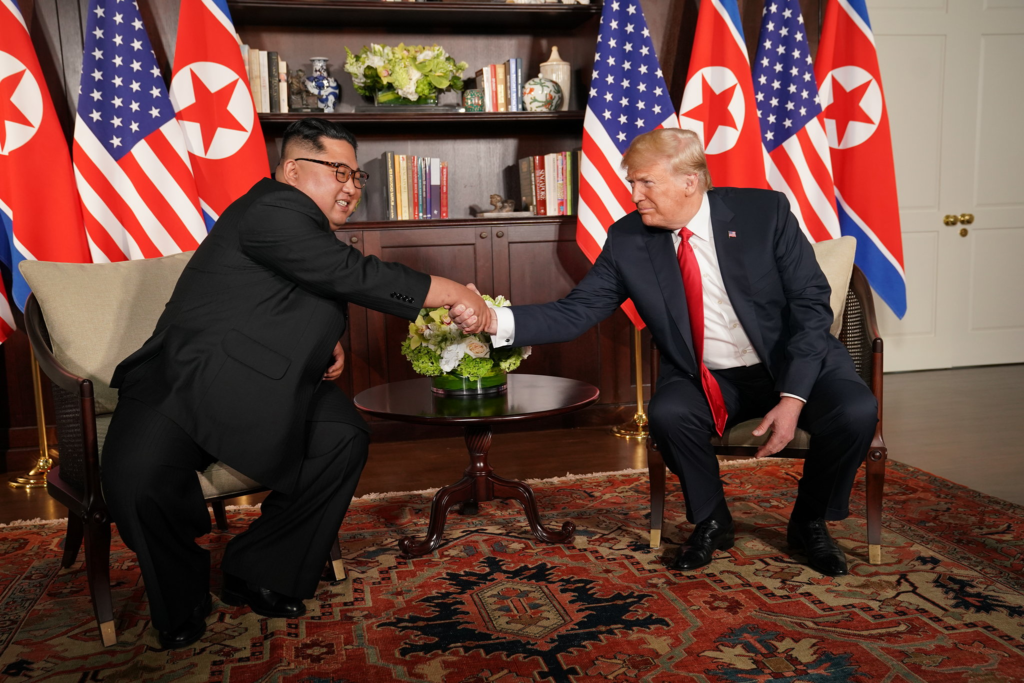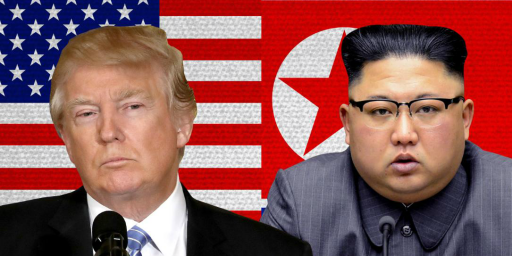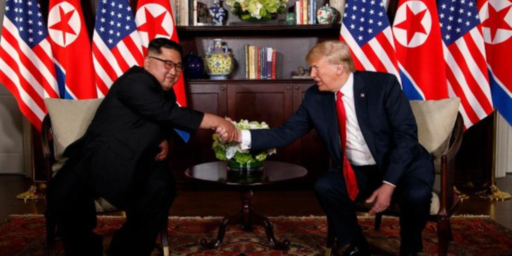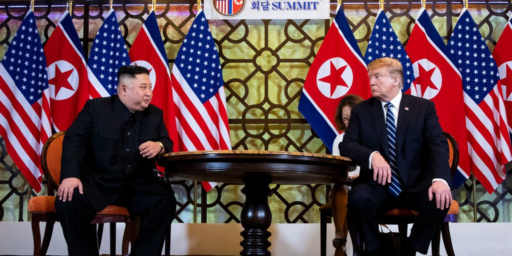Second Trump-Kim Summit Set For End Of February
The date and location of the next summit between President Trump and Kim Jong Un have been set, but it's hard to see what can really be accomplished.

One of the few newsworthy items to come out of the President’s State of the Union Address was the fact that the President announced a date for his second summit with North Korean leader Kim Jong Un:
WASHINGTON — President Trump announced on Tuesday that he will sit down with North Korea’s leader, Kim Jong-un, at the end of this month in Vietnam, a country chosen as a neutral location for their second nuclear summit meeting, but one that also has plenty of symbolic significance.
Mr. Trump hopes the meeting will jump-start a diplomatic effort that has stalled since their first encounter, last June in Singapore. While North Korea since then has refrained from overtly provocative actions like testing nuclear warheads or ballistic missiles, it has yet to agree to actually give up any piece of its atomic arsenal.
“If I had not been elected president of the United States, we would right now, in my opinion, be in a major war with North Korea,” Mr. Trump said in his State of the Union address on Tuesday night. “Much work remains to be done, but my relationship with Kim Jong-un is a good one. Chairman Kim and I will meet again on February 27 and 28 in Vietnam.”
Mr. Trump disclosed the location in an interview last week with The New York Times, but aides asked that it not be immediately reported, citing security concerns.
Mr. Trump visited Danang, Vietnam, for the first time in 2017 when he attended an annual summit meeting of the Asia-Pacific Economic Cooperation forum. As the site for his upcoming meeting with Mr. Kim, Vietnam offers a couple of possible allegorical lessons: On the one hand, it was the setting of the United States’ last major war in the region, a reminder of the devastating costs of conflict. On the other, it represents how a Communist regime can emerge from international isolation and build a thriving economy.
The forthcoming meeting is fraught for Mr. Trump, who has made a possible agreement with North Korea one of the signature goals of his foreign policy. After Singapore, he claimed prematurely that the North Korean nuclear dispute was “largely solved.” He regularly boasts of his close relationship with Mr. Kim — “we fell in love,” he once said — and regales visitors about the friendly letters he has received from the North Korean dictator.
As evidence of their rapprochement, Mr. Trump regularly notes that North Korea released three American prisoners and sent back what were believed to be the remains of 55 American soldiers who died in the Korean War.
But many experts have said North Korea is simply stringing Mr. Trump along, taking advantage of his inexperience and his desire for a breakthrough. His own intelligence chiefs told Congress last week that North Korea is “unlikely to completely give up its nuclear weapons and production capability,” as Mr. Trump has been seeking.
We already knew that there was a meeting being planned between Trump and Kim for some time in February based on statements that the White House had made last month, and the speculation at the time was that somewhere in Vietnam would be the likely location for the meeting, so this announcement doesn’t come entirely as a surprise. Trump’s announcement last night, though, sets a firm date for the meeting, although we have yet to confirm exactly where in that country the meeting would take place. Some locations that have been suggested have been Hanoi, Ho Chi Minh City, and Danang. Regardless of where it is, though, it seems as though we’re headed for another Trump-Kim summit meeting even though it’s entirely unclear what such a meeting can or will accomplish.
After the historic first meeting between Kim and President Trump, the Administration and the North Koreans both claimed that significant progress had been made between the two nations even though it was clear that it was really little more than a photo opportunity in which the two parties shook hands and signed off on a statement that ended up meaning far less than met the eye. After he returned from Singapore, the President even claimed that North Korea was no longer a nuclear threat to the United States, even though the reality of what has actually occurred is far more complicated. The two nations have continued talking, of course, but there have been long pauses in between those talks and several occasions on which it seemed as though the North Koreans in particular were giving up on the process due to what they claimed was a “gangster-like” attitude on the part of the American negotiators. It’s possible, of course, that there has been progress behind the scenes that we don’t know about, but it has not manifested itself publicly at this point.
This skepticism seems to be even more apparent when looking at what has occurred in public since the summit. This became apparent immediately after the summit as North Korea took steps that made it clear that there had been no real agreement by the North Koreans to “denuclearize” in the manner that the United States understands it. Within weeks after the summit, for example, it was reported that North Korea was increasing production of the fuel needed to make additional nuclear weapons and that it was concealing the existence of ongoing nuclear weapons research at secret facilities well hidden from both surveillance and, most likely, the ability of the United States to take the sites out in a military strike. Additionally, it became apparent in the days after the summit that the much-publicized destruction of the DPRK’s primary nuclear weapons test site, a much-hyped pre-summit event that was witnessed by American and other international journalists, was much less than met the eye and that the site could easily be rebuilt if needed in the future. Weeks later, we learned that the DPRK had also begun work on the construction of new ballistic missiles at yet another secret site.
So now here we are on the verge of a second summit between that two leaders and it’s obvious that the reality of what had been accomplished at the first summit did not meet the rhetoric. The actions that the DPRK has engaged in are not what one would expect from a nation that had agreed to “denuclearization” in the sense of giving up their existing nuclear weapons program. Additionally, analysts who have seen satellite images say that the DPRK has made a second large nuclear reactor operational. This type of reactor is capable of making plutonium which is, of course, one of the main fuels used in the production of nuclear weapons. This new reactor can reportedly make four times as much plutonium as North Korea’s current reactor, which has been the source for the plutonium needed for its nuclear arsenal to date.
Finally, and most recently, the North Koreans have returned to some of the more confrontational rhetoric that we’ve seen from them in the past. In December, they once again made clear what they meant by denuclearization, and that it is far different from what the United States and even the South Koreans mean. When the United States talks about “denuclearization,” it is principally referring to the idea that the goal of these current talks, indeed perhaps the only goal, is for the DPRK to give up its nuclear weapons, its weapons research program, and its ballistic missile program. Leaving aside the fact that the regime in Pyongyang is unlikely to do this simply because the existence of the nuclear arsenal they do have is perhaps the best deterrent available to guarantee the survival of the regime, this stands in stark contrast to what the North Koreans mean when they talk about “denuclearization.” For them, it means the removal of all American troops from South Korea if not the entire region, including Japan, and the lifting of the so-called nuclear umbrella that the United States has in place which essentially reserves the right to use nuclear weapons in response to any attack on its allies in Seoul, Tokyo, or elsewhere in the region. The Trump Administration either seems to not understand it or, at least in its public statements, refuses to recognize this reality. Kim Jong Un drove this point home during his New Year’s Day address earlier this month in which he stated that his country would move forward with its nuclear weapons program unless sanctions against his country were lifted.
It’s hard to see what can be accomplished at a second summit meeting, especially since there’s no indication that there is anything approaching a formal agreement between the two nations that could form the centerpiece of such a meeting. As I’ve said in the past there are things that could be accomplished if these negotiations were approached realistically. Tensions on the Korean peninsula, which have been on a razor’s edge since the end of the Korean War and ramped up significantly during the tit-for-tat exchanges that took place between President Trump and the North Korean leader throughout 2017, have calmed down significantly over the past year. Additionally, the relationship between North and South Korea appears to be better than it has been in several years during which the DPRK was engaged in provocative action such as firing missiles at a South Korean naval base and attacking a South Korean naval vessel. Making those changes permanent would be a good thing. Additionally, more formal negotiations aimed at bringing the Korean War to a formal end should be pursued, as should agreements designed to ease the conventional arms standoff across the Demilitarized Zone. However, as I have noted before (see here and here), if the United States continues to insist that the ultimate goal of these talks is the idea that North Korea will give up its nuclear arsenal, then these talks are doomed to fail. If this second summit moves talks in that direction then perhaps it might actually be a success. If all it does is end up being a repeat of Singapore, then it will once again be little more than a public relations stunt.




It’s easy to see what Kim gets. For one thing, he can claim, correctly. the first “summit” was neither a fluke nor a one-time thing.
As for Dennison, well, all I can come up with is he may be trying to make Putin jealous.
Oh, sure, but will Trump remember who Kim is? This morning, when asked about Adam Schiff, Trump claimed he’d “never heard of him.” Perhaps he believes that the “Little Adam Schitt” to whom he referred in a tweet is someone else.
Kim must be looking forward to his assignation with the dotard.
Oh, goody, this will be the summit where Kim will agree to destroy all his nukes and his missiles. I can’t wait!
I expect an even more stupendously successful photo-op.
WTF???? GAWD, we are so fortunate that he is as tunnel-visioned and stupid as he is!
@Just nutha ignint cracker: I couldn’t bring myself to watch the SOTU Follies. Did Agent Orange make that comment about being “in a major war with North Korea” with a hint of yearning in his voice?
@SC_Birdflyte: I’m not sure that I’ve ever watched STOU, so I don’t know either. I saw the comment, was all.
(Good thing I wasn’t in the audience. When I read the statement, “wtf” was what I shouted at the computer screen and I understand the acoustics in the House chamber are pretty bright.)